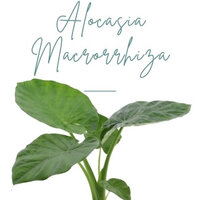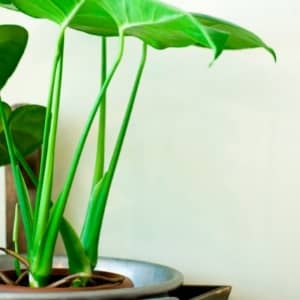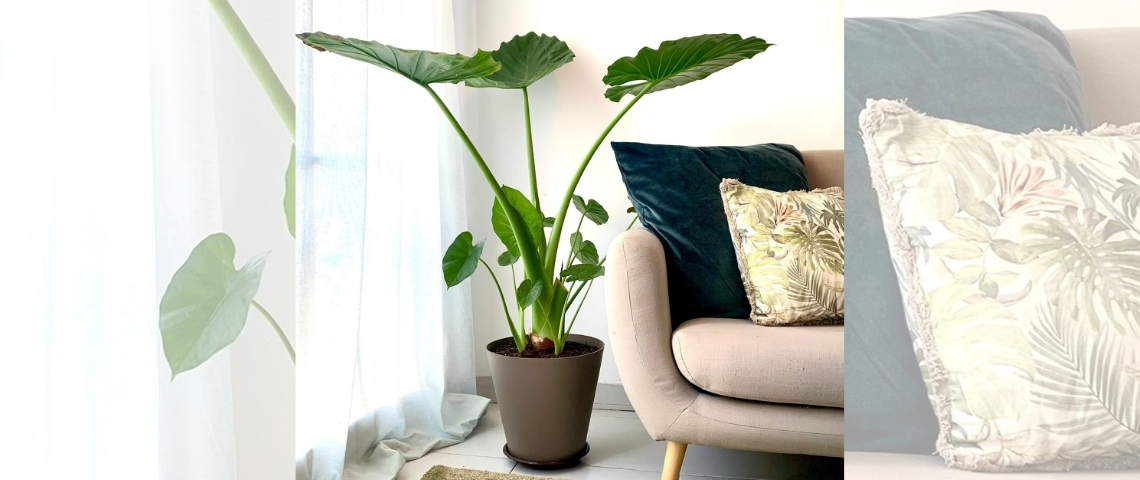-
Alocasia Macrorrhiza, the plant with the exotic touch that never fails

The alocasia macrorrhiza (alocasia macrorrhizos) is popularly known as the elephant's ear or marquise and is one of the favourite plants to decorate interiors, as it is elegant and brings a vintage touch that we love. It is the most visited plant on florespana.es and one of the best sellers.
But what is it that makes it really special?

properties
This plant, a member of the Alocasia family, is notable for its impressive size and stature. With leaves that are among the largest in the group, and one of the tallest, it's no wonder this species is nicknamed "elephant's ear" due to its substantial foliage.
its leaves
The striking foliage of Alocasia macrorrhiza boasts wavy, lance-shaped leaves that sprout from a sturdy stem, boasting an intensely vibrant green color that is unmistakable and captivating. The plant's extraordinary appeal is further enhanced by its stunning, bright red pine cone-shaped fruits, which add a pop of color to its already impressive display.
its origin
Originating from the tropical regions of Southeast Asia, this plant thrives in humid environments, such as islands or coastal areas. Interestingly, in some parts of its native region, Allocasia macrorrhiza is not only a popular ornamental plant but also serves as a source of food for both animals and humans.

why is it a perfect choice for your home?
The Alocasia Macrorrhiza is an ideal choice for creating a lush tropical atmosphere that can be paired with other Alocasias or paired with a palm tree for a stunning display. Its impressive leaves can grow to large sizes, but they are also adaptable to the space available, allowing them to thrive in a variety of settings. However, it's recommended to provide them with ample room to grow and spread out, as this will allow them to reach their full potential.
Furthermore, although it is one of our favourites for indoors, in favourable climates with humidity, it is also an excellent choice for our garden or terrace. The alocasia is an all-rounder of a plant.
care tips and considerations for a happy alocasia
There is an essential triangle that will give us the vital combo for the elephant ear: shade, warmth and good humidity. We'll explain the essentials:
humidity
Although the origins of this wonderful plant of the month are exotic, Alocasia Macrorrhiza is not complicated to grow. However, it is a plant that requires a lot of humidity, so don't forget to water it!
When it comes to caring for the humidity of our Alocasia, there are two key factors to consider. Firstly, the substrate: our elephant ear requires consistent and abundant watering, especially during the warmer months. In contrast, during the cooler months, it's best to adjust the watering schedule, ensuring that the substrate remains slightly damp between waterings.
The second factor is humidity. Ideally, you should have a humidifier near the plant if your climate is dry, but if this is not possible, there are other solutions: use a sprayer to spray water on the leaves.
temperature
It's no secret that humidity and heat can be a challenge. The ideal temperature range for an Elephant's Ear is between 10°C to 25°C, which is quite rare in Spain's winter months, especially in the Iberian Peninsula. As a result, unless you're living in the Canary Islands, it's best to keep your Elephant's Ear indoors and provide it with a warm and cozy environment, ideally within a well-insulated space.

shade
Where do we place our alocasia macrorrhiza so that it grows healthy?
outdoors
If you're blessed with a (sub)tropical climate, consider growing alocasia outdoors in a spot that receives partial shade, avoiding direct sunlight during the day. In its native Asian rainforest habitat, alocasia thrives alongside taller plants, which means it's accustomed to life in the shade. To ensure its well-being, also provide protection from harsh winds. It's recommended to grow alocasia in a container, allowing you to move it to a sheltered location if temperatures drop unexpectedly.
indoors
Remember to position the elephant's ear indoors in a spot that receives bright, indirect light, but always avoid direct sunlight. Never overwater your plant during winter, in summer it might be more thirsty. Turn your plant each month 45 degrees for a balnced growth.
any extra care?
To help your alocasia reach its maximum growth potential, it's essential to periodically transplant it into a larger pot every two years or so. This will provide the necessary room for the plant to thrive and flourish.
In addition, during the spring season, i.e. its growth stage, the elephant ear will need more of our care, as it starts to regrow and may need some extra nutrients. Keep an organic fertiliser at hand, preferably high in nitrogen, which will help the emergence of new buds and many future leaves.
buy alocasia macrorhizos
You could say that alocasia is a plant that gives a lot, and asks for little. Make any corner of your home more exotic with the plant of the season, and get it without shipping fees and our quality assurance!
alocasia:como puedo haserpara fomar una planta nueva. laocasia notiene esquejes. gracisas gracias G.R.M. jerez de a fron Guillermo Ramos Merlo
alocasia:como puedo haserpara fomar una planta nueva. laocasia notiene esquejes. gracisas gracias G.R.M. jerez de a fron Guillermo Ramos Merlo